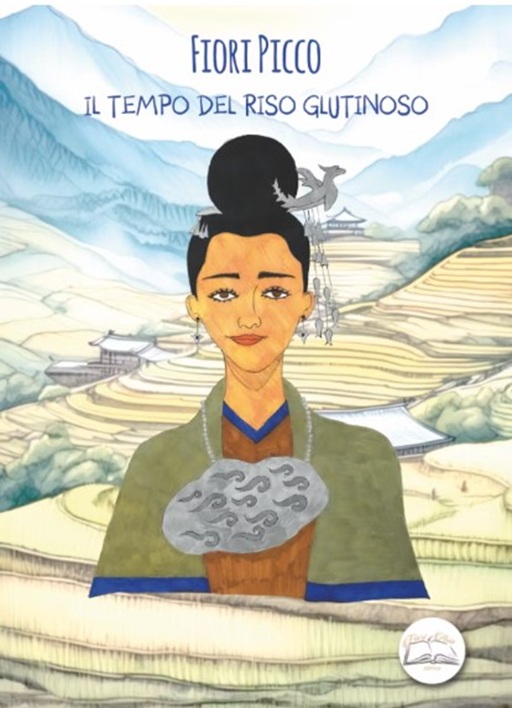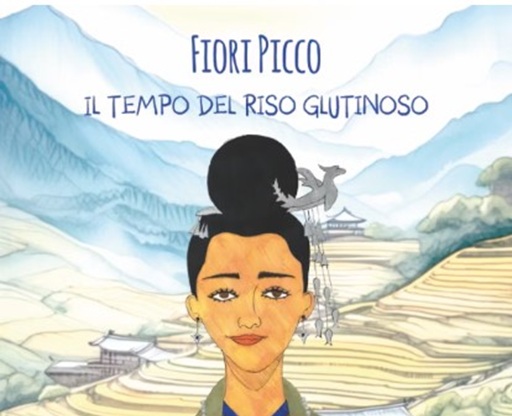Recensione di Maria Teresa De Donato
Con questo suo nuovo romanzo intitolato Il tempo del riso glutinoso (Picco, 2024, Fiori D’Asia Editrice) Fiori Picco, Autrice, Traduttrice letteraria, Editrice e Sinologa, conquista il cuore di noi tutti trasportandoci ancora una volta nel suo amato Yunnan e, più precisamente, nel villaggio di Shanjiao, tra la comunità Kam che da millenni abita in questa zona remota ai confini tra le province dello Hunan e del Guizhou.
Come nei suoi romanzi – Giada Rossa – Una vita per la libertà, Yao, e Il Circolo delle Donne Farfalla – Mugao e Bhaktu due aspetti caratterizzano anche questa pubblicazione:
- La figura della donna e della propria sofferenza e
- Il discorso legato alle etnie.
Tuttavia, se i precedenti romanzi costituiscono dei veri e propri reportage, Il tempo del riso glutinoso assume più i toni del viaggio introspettivo. L’Io e il Sé si scrutano a vicenda e si confrontano. La Mente, attraverso la Ragione, cerca di dare un senso a ciò che il Cuore inizialmente non accetta. Il Cuore, a sua volta, è diviso sul da farsi e, se da un lato si ribella a ciò che sente come un’imposizione, dall’altro desidera far contenti i propri cari, non deluderli e, soprattutto, non minare la serenità e l’equilibrio della famiglia.
Il risultato è una rivolta interna caratterizzata da un turbinio di pensieri, emozioni e sensazioni contrastanti e in perenne lotta tra loro.
Chi siamo? Dove stiamo andando e dove vogliamo andare? Siamo noi gli artefici del nostro destino o dovrebbero essere gli altri a decidere del nostro futuro e, forse, anche della nostra felicità?
Rinunciare alle proprie ambizioni, alla realizzazione dei propri sogni e assecondare il volere della propria famiglia per non deluderla perché “nella società Kam le responsabilità vengono al primo posto” (Picco, 2024, p. 11) sembra essere una spada di Damocle che pende sulla propria testa e da cui sarà molto difficile se non addirittura impossibile liberarsi.
La posta in gioco è altissima. Cosa fare dunque? Ribellarsi continuando a coltivare i propri talenti e a perseguire i propri sogni, quale ad esempio quello di diventare “architetta progettista trilingue e un giorno approdare all’estero, preferibilmente in Italia” (p. 15) dopo aver conseguito una laurea a pieni voti presso la Facoltà di Progettazione di Giardini e di Paesaggi dell’Università Normale dello Yunnan, a Kunming, scelta ispirata anche dalla docente italiana di cultura europea e Design di giardini, oppure accettare e far proprio l’insegnamento di mamma Beili secondo cui “Non è detto che la vita vada sempre come vogliamo. Certe cose possiamo farcele piacere con il tempo.”? (p. 15)
E così, mentre il nostro Cuore è affranto e, combattuto, si domanda sul da farsi, la Vita stessa, a nostra insaputa, spiana la strada, prepara il sentiero che ci porterà alla Comprensione, alla piena Consapevolezza della nostra identità etnica, all’accettazione e, infine, a ricoprire quella che dimostrerà di essere la nostra vera “chiamata”.
Diventare la sindaca di Shanjiao dovrebbe inorgoglire. Essere “la donna più autorevole e rispettata del luogo” in “una società matriarcale chiamata ‘il Regno delle figlie’” in cui le donne detengono il potere è il sogno di tutte le ragazze di etnia Kam (p.11), anche se tale privilegio è riservato solo a donne laureate.
La Vita, tuttavia, vedrà proprio in Niangmei, soprannominata dalla docente italiana “Myrtle” (= Mirto), una ragazza di Kunming, colta e intelligente, la persona più idonea per guidare il villaggio di Shanjiao, per diventare una delle “messaggere dei grandi antenati” (p. 269) e delle “nuove eredi del patrimonio culturale immateriale dell’etnia Kam” (pp. 254, 255) nominate tali dallo stesso Governo distrettuale.
Malgrado la sua giovane età e inesperienza, Myrtle dimostrerà di avere la capacità, anche grazie ai consigli dei suoi genitori, della zia Wu ex sindaca di Shanjiao, di quella che diventerà la sua amica Yilan, e di altri personaggi tanto affascinanti quanto misteriosi, tra cui la Nonna Pan e Rong Rong, di essere all’altezza della situazione. Ricoprendo in maniera eccellente il suo ruolo di sindaca, riuscirà, non senza difficoltà, a far sviluppare il proprio villaggio tramite una serie di iniziative atte a bonificare l’ambiente e a incrementare artigianato, commercio e turismo grazie anche all’uso mirato di internet. Così facendo proverà, senza alcuna ombra di dubbio, di essere la degna rappresentante terrena ed erede della Grande Nonna Sama, Dea del luogo.
Il riso glutinoso, citato varie volte nel testo e utilizzato in varie ricette tradizionalmente preparate e consumate dalla comunità Kam, sembra essere la metafora di una invisibile clessidra che, a intervalli regolari, scadenza lo scorrere lento e incessante del tempo scandendone il ritmo.
Tradizioni culturali, culinarie, e religiose, credenze millenarie fortemente radicate, descrizioni dettagliate di usi e costumi, pietanze, abbigliamento, rituali cerimoniali, segreti di famiglia e non solo, vecchi dissapori esistenti tra membri della comunità per le ragioni più svariate vengono magistralmente descritti dall’abile penna di Fiori Picco.
Ne esce un quadro fortemente suggestivo che trascina il lettore in un’atmosfera e in un tempo che, a noi occidentali, sembrano lontani anni-luce e che proprio per questo intrigano e affascinano facendoci vibrare in una dimensione reale e al tempo stesso mistica. Colori, sapori, suoni, voci, canti, oltre a palazzi e statue che sembrano osservare passanti e lettori si confondono in un Tutto tanto variegato quanto armonico che ci trasporta in un Mondo ‘altro’ in cui miti e leggende, così come fantasia e realtà, continuano a danzare incessantemente.
Il tempo del riso glutinoso è un libro ricco di particolari che affascinerà il lettore consentendogli di continuare il suo viaggio spirituale nello Yunnan e di familiarizzare questa volta con l’etnia Kam e la sua società matriarcale.
Ne consiglio la lettura a tutti, soprattutto agli amanti delle culture straniere.
Articolo già pubblicato al seguente link:
https://holistic-coaching-dedonato.blogspot.com/2025/01/il-tempo-del-riso-glutinoso-fiori-picco.html
The Time of Glutinous Rice
by Fiori Picco
Review by Maria Teresa De Donato
With her new novel entitled Il tempo del riso glutinoso (= The Time of Glutinous Rice) (Picco, 2024, Fiori D’Asia Editrice), Fiori Picco, Author, Literary Translator, Editor, and Sinologist, conquers the hearts of all of us by transporting us once again to her beloved Yunnan and, more precisely, to the village of Shanjiao, among the Kam community that has lived in this remote area on the border between the provinces of Hunan and Guizhou for millennia.
As in her novels – Giada Rossa – Una vita per la libertà (= Red Jade – A Life for Freedom), Yao, and Il Circolo delle Donne Farfalla – Mugao e Bhaktu (= The Butterfly Women’s Circle – Mugao and Bhaktu), two aspects also characterize this publication:
- The figure of the woman and her suffering and
- The theme of ethnic groups
However, if the previous novels constitute real reportages, The Time of Glutinous Rice takes on more the tones of an introspective journey. The Ego and the Self scrutinize each other and compare themselves. The Mind, through Reason, tries to make sense of what the Heart initially does not accept. The Heart, in turn, is divided on what to do and, if on the one hand, it rebels against what it feels as an imposition, on the other, it wants to make its loved ones happy, not disappoint them, and, above all, not undermine the serenity and balance of the family.
The result is an internal revolt characterized by a whirlwind of contrasting thoughts, emotions, and sensations that are constantly in conflict.
Who are we? Where are we going, and where do we wish to go? Are we the architects of our destiny, or should others decide our future and, perhaps, our happiness? Giving up on our ambitions, on the realization of our dreams, and indulging in the wishes of our family so as not to disappoint them because “in Kam society, responsibilities come first” (Picco, 2024, p. 11) seems to be a sword of Damocles hanging over one’s head and from which it will be very difficult if not impossible to free oneself.
The stakes are very high. So what to do next? Rebel by continuing to cultivate one’s talents and pursue one’s dreams, such as that of becoming a “trilingual architect designer and one day landing abroad, preferably in Italy” (p. 15) after graduating with full marks from the Faculty of Garden and Landscape Design of the Yunnan Normal University, in Kunming, a choice also inspired by the Italian professor of European culture and Garden Design, or accept and make one’s own the teaching of mom Beili according to which “It is not a given that life always goes the way we want. There are certain things we can make ourselves like with time.”? (p. 15). And so, while our Heart is broken and, torn apart, it wonders what to do next, Life itself, without our knowledge, paves the way, and prepares the path that will lead us to Understanding, to full Awareness of our ethnic identity, to acceptance and, finally, to cover what will prove to be our true “calling.”
Becoming the mayor of Shanjiao should make one proud. Being “the most authoritative and respected woman in the place” in “a matriarchal society called ‘the Kingdom of Daughters'” where women hold power is the dream of all girls of the Kam ethnic group (p.11), even if this privilege is reserved only for women with degrees. However, Life will see in Niangmei, nicknamed “Myrtle” by the Italian teacher, a cultured and intelligent girl from Kunming, the most suitable person to lead the village of Shanjiao, to become one of the “messengers of the great ancestors” (p. 269) and of the “new heirs of the intangible cultural heritage of the Kam ethnic group” (pp. 254, 255) appointed as such by the district government itself.
Despite her young age and inexperience, Myrtle will demonstrate that she has the ability, also thanks to the advice of her parents, her aunt Wu, the former mayor of Shanjiao, the one who will become her friend Yilan, and other characters as fascinating as they are mysterious, including Grandma Pan and Rong Rong, to be up to the task. Carrying out her role as mayor excellently, she will succeed, with difficulty, in developing her village through a series of initiatives aimed at reclaiming the environment and increasing craftsmanship, trade, and tourism, thanks also to the targeted use of the internet.
In doing so, she will demonstrate, without a shadow of a doubt, that she is the worthy earthly representative and heir of the Great Grandma Sama, Goddess of the place.
The glutinous rice, mentioned several times in the text and used in various recipes traditionally prepared and consumed by the Kam community, is the metaphor of an invisible hourglass that, at regular intervals, expires the slow and incessant passage of time, marking its rhythm.
Cultural, culinary, and religious traditions, deeply rooted millenary beliefs, detailed descriptions of customs and habits, dishes, clothing, ceremonial rituals, family secrets, and more, old disagreements existing between members of the community for the most varied reasons are masterfully described by the skilled pen of Fiori Picco.
The result is a highly suggestive picture that drags the reader into an atmosphere and a time that to us, Westerners, seems light-years away and that, for this very reason, intrigues and fascinates, making us vibrate in a real and, at the same time, mystical dimension. Colors, flavors, sounds, voices, songs, as well as buildings and statues that seem to observe passers-by, as well as readers, blend into a Whole as varied as it is harmonious that transports us to an ‘other’ World in which myths and legends, as well as fantasy and reality, continue to dance incessantly.
The Time of Glutinous Rice is a book rich in details that will fascinate the readers, allowing them to continue their spiritual journey in Yunnan and to familiarize themselves this time with the Kam ethnic group and its matriarchal society.
I recommend reading it to everyone, especially lovers of foreign cultures.
This article was already published at the following link:
https://holistic-coaching-dedonato.blogspot.com/2025/01/the-time-of-glutinous-rice-fiori-picco.html







